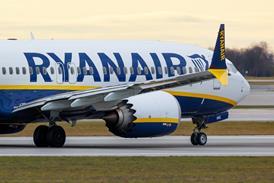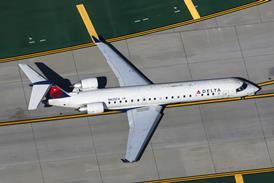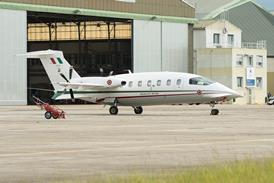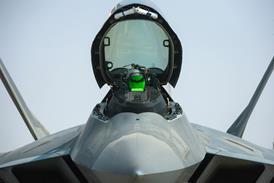KATE SARSFIELD / LONDON. DATA COMPILED BY BUCHAIR UK
There are more business aircraft flying compared to a year ago, but the rise in numbers is deceptive as order backlogs shrink and customer caution increases
The world's business aircraft fleet continues to grow, increasing in the past 12 months by more than 2% to around 20,200 aircraft. Behind this increase, however, the market is slowing as manufacturers work off their shrinking order backlogs and customer caution, fuelled by economic uncertainly, threatens to hinder growth.
According to the US General Aviation Manufacturers Association (GAMA), in the first half of this year deliveries of business jets fell by almost 10% from 396 aircraft to 357, while turboprop deliveries tumbled by almost half, from 204 units to 111. Manufacturers that had been hoping for a recovery in the second half of the year now expect a further decline in deliveries, followed by a flat 2003, with no recovery expected before 2004.
Although Flight International's annual corporate aircraft survey reveals nearly 11,400 jet-powered aircraft and almost 8,800 turboprops in service, this year's increase in fleet numbers is attributable almost entirely to the number of jet deliveries. In contrast, the turboprop fleet has remained static for around five years.
Nowhere is this more apparent than in the growth of entry-level jets, led by Cessna's Citation CJ1 and CJ2, which are similarly priced to turboprops. The CJ1 fleet has swelled from 86 to 131 units in a year, while the number of larger CJ2s has leapt threefold, from 30 to 92 units during the same timeframe. Raytheon's new Premier 1 also boasts a fleet of 33 aircraft.
Some niche turboprop manufacturers continue to have a degree of success, notably the single-turboprop EADS Socata TBM700, New Piper Malibu Meridian and Pilatus PC-12. Of these, the Swiss-built PC-12 saw the greatest rise in numbers over the past 12 months, from 283 to 346. Europe recorded the largest fleet increase, from 25 to 80 aircraft, due in part to the relaxing of restrictions on commercially operated single-engined aircraft.
But even deliveries of these aircraft slowed in the first half. With the exception of a clutch of new models, including the Ibis Aerospace Ae270 and Myasichev M101T, few turboprops are expected to make their mark on the business-aircraft market for the foreseeable future and the gap between the jet and turboprop sectors looks set to widen in future surveys.
The explosion in fractional ownership has been instrumental in driving the growth of the business-jet sector, with programmes such as NetJets having placed orders at a relentless pace throughout the last decade. Fractionals have boosted fleet numbers in every sector of the business-jet market, but while demand for certain types remains strong, for others the rate of growth is slowing.
Among the fastest growers have been the super light Bombardier Learjet 45 and Cessna Citation Excel, which together account for 466 aircraft in the census. In the past 12 months, Excel numbers have leapt by 30% to 264 aircraft, while the Learjet 45 fleet has climbed by 25% to 202 aircraft.
The super mid-size sector has also had a buoyant period. The Cessna Citation X fleet has increased by 29 aircraft, Dassault Falcon 2000 numbers have risen from 152 to 181 and the fleet size for the Gulfstream 200 (formerly the Galaxy) has more than doubled, from 20 aircraft to 46. NetJets is the largest single customer for all three types.
Newcomer Embraer has begun deliveries of its Legacy super mid-size business jet derivative of the ERJ-135 regional jet, with six aircraft entering service. Increased activity is expected in this sector in 2003 and 2004 as Bombardier and Raytheon begin deliveries of their respective Continental and Hawker Horizon business jets.
In the mid-size sector, the Bombardier Learjet 60, Dassault Falcon 50EX, Gulfstream 100 (formerly Astra SPX) and Raytheon Hawker 800XP account for 648 aircraft, an increase over the previous 12 months of 62 units. With an orderbook 125-aircraft strong, deliveries of Cessna's mid-size Citation Sovereign will begin to make an impact on the census in 2004.
Fleet increases
In the large business-jet category, the Bombardier Challenger 604 and Dassault Falcon 900EX fleets each increased by 29 aircraft. Gulfstream's market leading GIV-SP edged forward by 13 units to 262. The first head-to-head challenger for the GIV-SP, Bombardier's new Global 5000, is set to make an impact from 2004.
Gulfstream continues to hold pole position in the ultra-long-range market, with the company increasing its lead over Bombardier. Its GV fleet rose in the past 12 months from 132 to 151 aircraft, while Global Express numbers rose from 71 to 87. Gulfstream's improved GV-SP will enter service next year and Bombardier is expected to enhance the Global Express.
The widebody business-jet sector appears to be a one-horse race. Airbus has yet to seal a sizeable order for its A319 Corporate Jetliner (ACJ) and continues to trail the rival Boeing Business Jet. In the past 12 months, according to the census, the ACJ fleet has dipped from 10 to nine aircraft, while BBJ numbers, assisted by a partnership with NetJets, rose from 51 to 64. On top of this, the bigger 737-800-based BBJ2 also entered service in the past year, with the census showing a fleet of seven aircraft.
China recorded a rise of five business jets in the past 12 months, while the combined fleets of Bahrain, Brunei and the United Arab Emirates climbed by five aircraft.
Source: Flight International























